Just like taking a flight, there is a baggageallowance to adhere to when taking a train. Please read on to see how many bagsyou can take on a train in China, and where to place them.
Weight and Size Limits
The maximum weight and size for free carry-on baggage for eachpassenger is as follows. All items exceeding this should be consigned to a rail freight car (see How to Consign Your Baggage) or mailed separately.
Free Baggage Allowance
- Child (including those with a free ticket): 10 kg (22 lbs)
- Adult: 20 kg (44 lbs)
- Diplomat: 35 kg (77 lbs)
Baggage Size
For normal trains:
- The total of the three dimensions (length + width + height) of each item must not exceed160 cm (63 in). For example 70cm x 40cm x 50 cm would be just withing the limit.
- The exception is a rod-shaped item (like a fishing rod in its case, or a tube containing a painting), which must not exceed 200 cm (79 in). Width restrictionsare not specified, but presumably “rod-shaped items” must be less than about 10 cm (4 in) in diameter.
For high-speed trains (C, D, and G trains):
- The total of the three dimensions cannot exceed 130 cm (51 in).
- A rod-shaped item cannot exceed 130 cm (51 in).
The weight and size limits detailed above are not applicable to a wheelchair, which has unrestricted access for being taken on board.

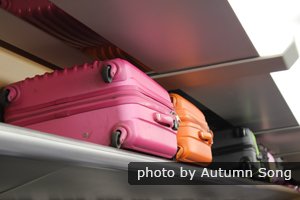
In practice, there is no steel box to put your baggage in, like in airports. So, generally speaking, you won’t be stopped at the security check, unless what you’re carrying is obviously in violation of the size/weight restrictions. Bikes aren’t allowed as carry-on baggage, unless folded to the dimensions above.
However, baggagespace is limited and it is better to store your baggage near you in your car, so itis recommended to travel lightly. Your luggage must fit safely on the overhead racks with no parts or straps overhanging. Loose items, like water bottles, that may fall out of a bag or off the rack are routinely required to be repacked or held.
Things You Can’t Bring on a China Train
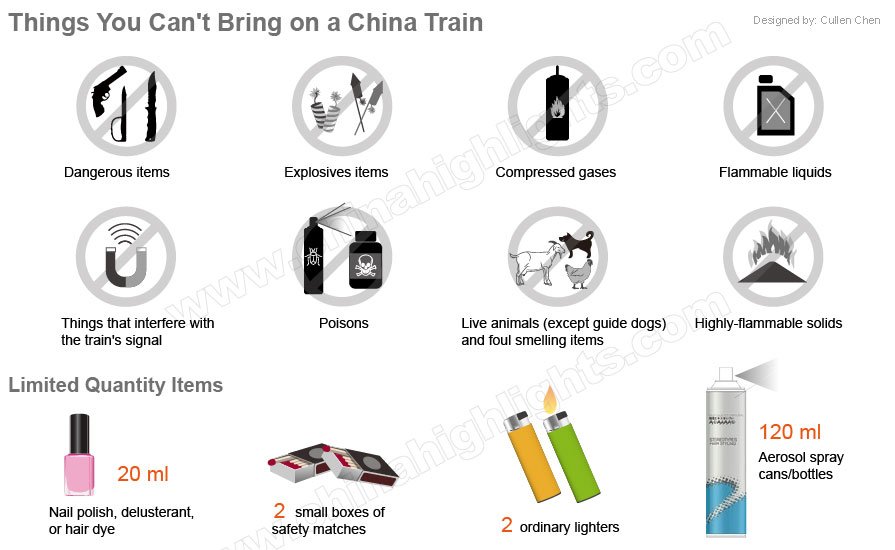
Prohibited Items
The items listed below are not permitted on a train or in a trainstation:
- Dangerous items: any weapons, such as knives and guns, and offensive items,including imitation guns, and any type of bullets
- Explosives: items with an explosive quality, such as firecrackers
- Compressed gases: petroleum gas, coal gas, oxygen, hydrogen, etc.
- Flammable liquids: alcohol, adhesives, thinners, spray paint, gasoline and other fueloils, etc.
- Highly-flammable solids: camphor, hexamine and other solid fuels, etc.
- Poisons: arsenic trioxide and all types of “toxins”, pesticide powder,termite powder, pesticide spray, etc.
- Live animals (except guide dogs) and foul smelling items
- Things that interfere withthe train’s signal
Limited Quantity Items
You can take the following items on a train in limited quantities:
- Nail polish, delusterant, or hair dye (up to 20 ml)
- Aerosol spray cans/bottles (up to 120 ml): mousse, hairspray, airfreshener, etc.
- Two small boxes of safety matches
- Two ordinary lighters
Where to Put Your Baggage on a Train
Baggage space is limited and it is better to store your baggage near you in your car, so it is recommended to travel lightly.
On a High-Speed Train (G, D and C Trains)
 Luggage racks are over the seats at either side of a carriage.
Luggage racks are over the seats at either side of a carriage.Luggage racks for 24-inch suitcases: There are luggage racks over the seats at either side of a carriage.
- Size: 45 – 50 cm wide, 50 – 60 cmhigh (suitable for a 24-inch suitcase)
Shelves for larger suitcases: At the joint between two cars, you can place your large suitcases on the shelves.
- Height: 1 m (suitable for a 28-inchsuitcase)
Room behind the last row of seats: Usually there will be a certain amount of room between the last row of seats and the wall of a car to put large suitcases.
- Size: the length of the seats and the width of a standing passenger
Special notice:
1. Your luggage must fit safely on the overhead racks with no parts or straps overhanging. Loose items, such as water bottles, that may fall out of a bag or off the rack are routinely required to be repacked or held.
2. Be aware that the shelf space is very limited and suitcases may be piled on top of one another. It’s recommended to check-in early and place your items inward if you are going to have a long journey and don’t want others to move your belongings in and out.
3. Sometimes, the room behind the last row of seats will be occupied by passengers who purchased standing tickets.

Barrier-Free Wheelchair Car
Each D/G train has a barrier-free carriagewith wide corridor access and a disabled toilet. This is usually, for example, the fourth car (central on a typical 8-car train), and so closest to the platform-access lift, and usually the bar car too. This includes:
- A place for wheelchairs to park, with a belt to fasten them.
- Sockets to charge electric wheelchairs for free.
Ordinary Speed Trains
For seat cars:
Luggage racks above the seats: The space available in racks in normal trains is bigger than that found in high-speed trains.
- Width and height: Each rack isabout 55 cm wide and 50 cm high (22*19 in) and a large 28-inch suitcase can be placed on one.
Room under your seat: If there is no spaceon a rack to place your baggage, you can place it under your seat.
- Height: 30 cm
Room under the small table: There is asmall table between the seats. If your suitcase is too heavy to place on theluggage rack, or too thick to place under your seat, you can put it under thesmall desk that is near your seat.
- Height: 70 cm
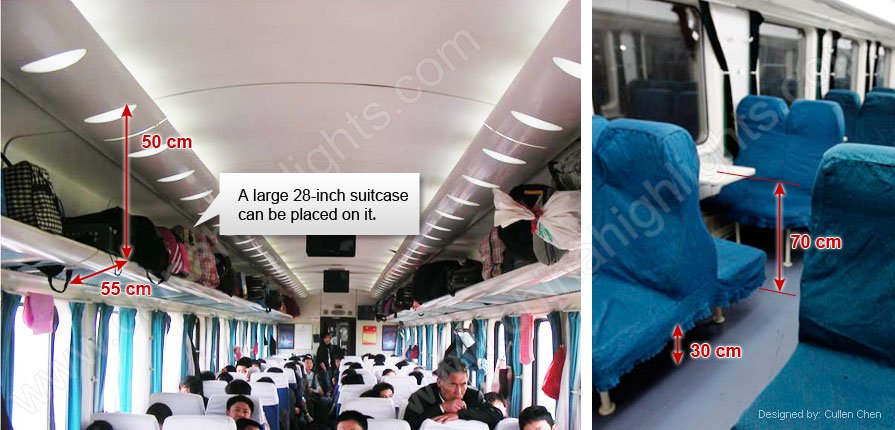
For Sleeper Cars:
If you are taking a sleeper car, you can place your baggageon the opposite side to the berths, under the lower berth, or under the smalldesk in your compartment.
- Height: 50 cm wide and 40 cmhigh in the luggage rack, 25 cm under a berth, and 70 cm under the small desk
Special notice:
1. It’s sensible to put your baggage on the luggage rack that is opposite your seat, so that you can keep an eye on it.
2. High-value items should be kept where they are accessible to you, especially when in a sleeper car. Lights will be turned off around 10pm in a sleeper car.
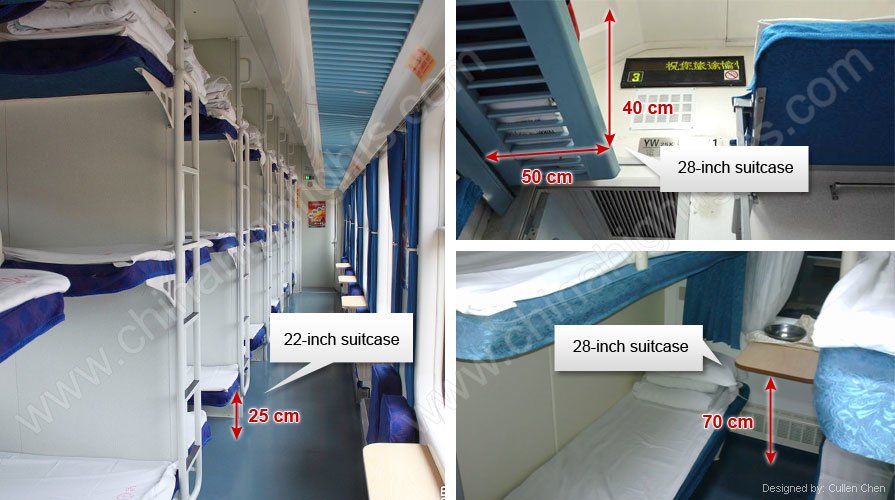
How to Consign Your Baggage
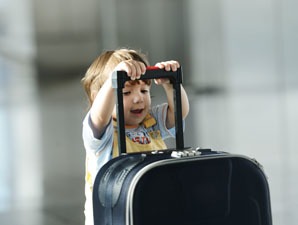
If you don’t want to carry too much baggage with you, you can optfor baggage consignment at the train station before departure. Usually, your baggage can be transported in a freight car on the same train as you. This enables you to collect your baggage when you arrive at the train station.
How to Use Baggage Consignment
1. Find the Baggage Consignment Office
The baggage consignment office (in Chinese: 行李托运处) is usually justbeside the ticket office.
2. Fill in the Form
The staff will give you a form to fill in (in Chinese) with your name, address, phone number, amount and weight of items. If you don’t know how to fill in the form, you can ask staff members for help.
When you show your train ticket and pay you’ll be given a consignmentcollection voucher for the equivalent journey.
Remember to pack your fragile items and electronic products carefully,as they may be damaged during transportation. You can buy consignment insurancefor them there.
See Taking a Bike on a Train in China if you wouldlike to consign your bicycle.
3. Pay the Consignment Fee
The consignment fee is calculated according to your baggage’s weightand the journey’s distance.
- Starting weight: 1 kg
- Starting distance: 20 km
Prices also vary with baggage type, so we can’t give youexact prices. But usually the price is much cheaper than express delivery. Ifyour luggage exceeds 50 kg, the overweight baggage consignment price is double theequivalent price below 50 kg.
- Maximum weight: 50 kg (110 lb), 75 kg ifa wheel chair is included in the baggage.
- Size: It must be able to fit through aluggage car (approx. 2m high and 1m wide), and must measure no less than 0.01 cube, which isthe volume of a 21 cm (8 inch) cube.
Special notice:
1. High-value items should be escorted: Your consigned baggage should not contain high-value amounts of any currency, bonds, cultural and historical relics, gold, silver, and jewelry, or important documents or materials. You can arrange an escort service for these valuable items.
2. Prohibited/restricted items are also not allowed to be consigned.If your baggage contains items that are restricted by the government regulations, please provide transport certificates. See Customs Regulations for restricted items.
3. High-speed trains don’t currently provide a baggage consignment service.
Usually, there are closets for large baggage at the joint between two cars on high-speed trains.
If you still need a baggage consignment service, you can consign your baggage on an ordinary speed train. The disadvantages are that your baggage will not arrive at the same time as you and you may need to go to another train station to collect it.
Collecting Your Baggage
After you and your baggage have arrived, you can collect yourbaggage using the baggage collection vouchers that the carrier gave you.
The carriers will keep your baggage without charging a fee for threedays. If you fail to collect your baggage within three days, you will need topay a storage fee.
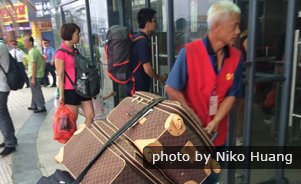 A luggage porter in red jacket
A luggage porter in red jacketLuggage Porters
If your baggage is too heavy to carry byyourself, you can find a “red cap” luggage porter to help you take it on yourtrain. There are usually some staff members in red caps or red jackets at arailway station. You can see them easily in front of the train station.
The service fee is about 20 yuan (3 USD) for each item.
Recommended Train Travel Tours in China

If you are planning a tour in China and want to experience a high-speed train, please see the following itineraries for inspiration:
- 5-Day Shanghai and Its Neighbors Bullet Train Tour – modern Shanghai and traditional water towns
- 12-Day China Train Safari from North toSouth China – highlights of China in Beijing, Xi’an, Guilin, Guangzhou, and Hong Kong
- See more China Train Travel Tours
Not interested in the above tours? Our tours can be customized or tailor-made from scratch. Just tell us your interests and requirements and we will help you design your China tour.
Get smart train travel guide from our app, China Train Booking. Download app now, both available for IOS and Android.
Related Articles
- How to Buy Train Tickets in China – 5 Ways
- High-Speed Train in China (Bullet Train)
- How to Choose Between Train Types and Seat Classes in China


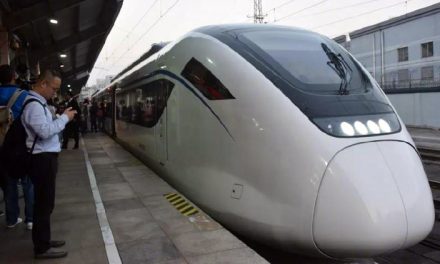

Recent Comments